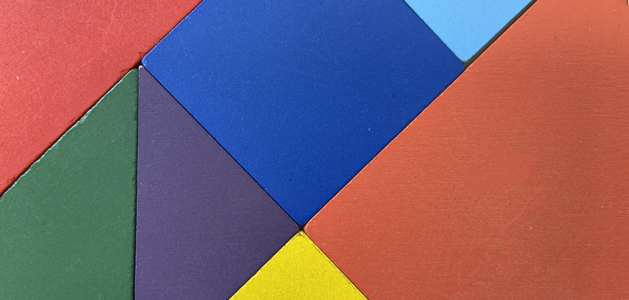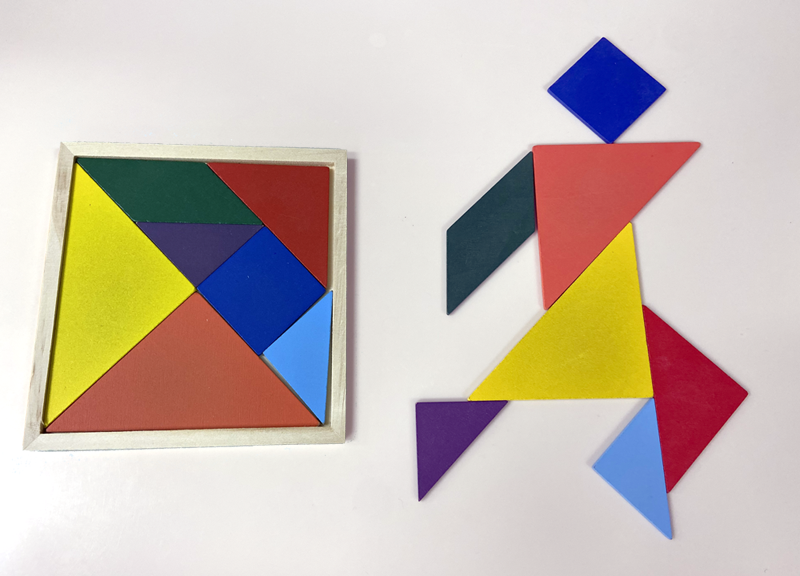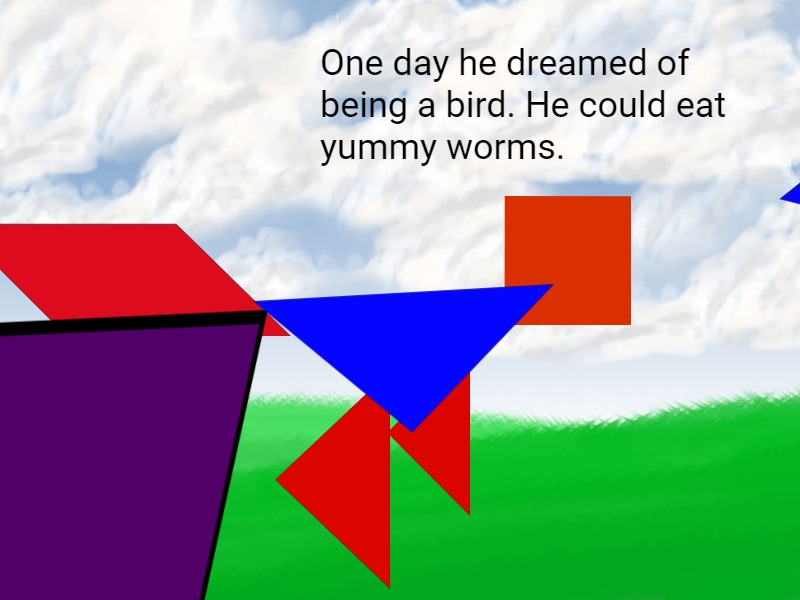
Students solve tangram puzzles and then create a new shape using the shapes in the Tangram square and tell its story.

The tangram puzzle originated in China hundreds of years ago and has been a favorite shape challenge around the world. After having students solve shape challenges using all pieces in the tangram square, ask them to create their own tangram shape and write a story about its adventure.
Give students a complete set of tangram shapes consisting of 2 large triangles, 3 smaller triangles, 1 square and 1 rhombus.
Begin by asking questions like:
Distribute tangram shape puzzles for students to solve or use a program like Wixie to complete them online.

Download a Tangram Shapes printable.
Tangram puzzles are not all the same level of difficulty, so partner students together to solve some of the more difficult shapes like the dancing man pictured above. This provides students with an authentic opportunity to use shape and position vocabulary and work on precise descriptions.
Read Grandfather Tang's Story by Ann Tompert. In this tale, a grandfather rearranges the shapes in the tangram to make new shapes that reflect the characters and events in the story.
Ask your students to begin playing with tangram pieces to make their own shapes. As they begin putting pieces together, encourage them to move from abstract to recognizable composite shapes. They can ask a classmate or two to guess what the shape represents.
Students can trace the outline of their composite shape on paper to create a new tangram puzzle.
To add a literacy component, ask students to tell a story about their tangram shape. Once again, they can trace their composite shape onto a piece of paper and add text and illustrated details.

If you are using a digital tool, like Wixie, students can easily move tangram shapes around to form their composite shape and then record an oral story using the device's microphone. Emerging writers can still type their stories, but will be able to share a much more elaborate tale if they only need to speak to share their ideas.
To celebrate their work, have students share their new tangram shape puzzle with classmates. When a student finishes, they can trade pages with another classmate to continue building spatial reasoning.
If your students have told tangram tales, read their stories to the rest of the class or at a family event.
If you have used a digital creativity tool, combine the pages into a class book. Print the pages to create and add to your classroom library, or better yet, post online to share a version that includes student voice. If you export as an eBook or PDF, students can download and read, or listen, to the story from devices at home.
This lesson provides an opportunity to build spatial reasoning, practice geometric vocabulary, and tell stories. You will be able to easily evaluate a student's spatial reasoning skills as soon as they try to solve existing tangram puzzles.
Each student's imagination and writing capabilities can be assessed through the shape they create and the story they tell.
Differentiate for a range of language skills by asking some students to write and others to tell the story orally. To reinforce reading skills, add the text of their oral storytelling yourself or capture a video of their storytelling as they hold the image.
Ann Tompert.Grandfather Tang's Story. ISBN: 9780517885581
VA:Cr1.1.1a
Engage collaboratively in exploration and imaginative play with materials.
VA:Cr3.1.1a
Use art vocabulary to describe choices while creating art.
VA:Re8.1.1a
Interpret art by categorizing subject matter and identifying the characteristics of form.
1.G.1. Distinguish between defining attributes (e.g., triangles are closed and three-sided) versus non-defining attributes (e.g., color, orientation, overall size) ; build and draw shapes to possess defining attributes.
1.G.2. Compose two-dimensional shapes (rectangles, squares, trapezoids, triangles, half-circles, and quarter-circles) or three-dimensional shapes (cubes, right rectangular prisms, right circular cones, and right circular cylinders) to create a composite shape, and compose new shapes from the composite shape.
6. Creative Communicator
Students communicate clearly and express themselves creatively for a variety of purposes using the platforms, tools, styles, formats and digital media appropriate to their goals. Students:
a. choose the appropriate platforms and tools for meeting the desired objectives of their creation or communication.
b. create original works or responsibly repurpose or remix digital resources into new creations.
d. publish or present content that customizes the message and medium for their intended audiences.

Follow us on Instagram for daily inspiration

Create a thought web, cluster, flowchart, or other graphic organizer for a lesson
8 first projects to get students using technology
Creative, digital book reviews
Fun and powerful ideas with animated characters

Wixie
Share your ideas, imagination, and understanding through writing, art, voice, and video.

Rubric Maker
Create custom rubrics for your classroom.

Pics4Learning
A curated, copyright-friendly image library that is safe and free for education.

Wriddle
Write, record, and illustrate a sentence.

Get creative classroom ideas delivered straight to your inbox once a month.
Topics